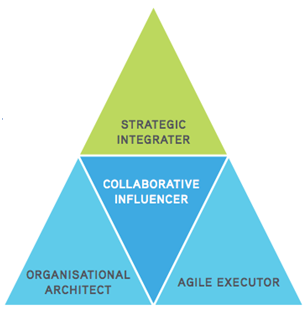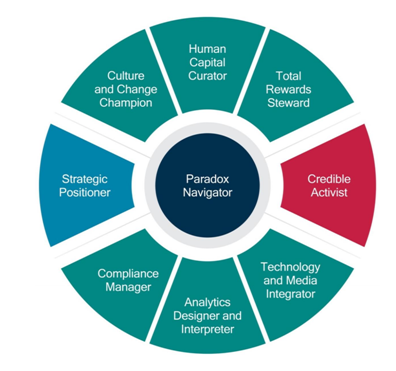HR Transformation Strategy and Planning
By: Ciopages Staff Writer
Updated on: Feb 25, 2023

Human Resources or HR Transformation Strategy and Planning has taken center stage in recent years across the global in mid-to-large enterprises. Hitherto, companies focused on HRMS (Human Resources Management Systems) or HCM (Human Capital Management) solutions because they had to, not necessarily because they wanted to invest and upgrade HR processes and systems. Today, the twin engines of digital transformation and the ascent of millennials as the largest demographic cohort are driving the need for transforming the stodgy and old HR function into a hip, agile, transparent, responsive and employee-centric service.
HR transformation, like any other enterprise business transformation, is a steep mountain to climb. A real Human Resources functional change involves a leap involving people, process, technology, and data. It requires significant change management, adoption, and training issues. Moreover, without a well-thought-out HR Transformation Strategy and Planning, the HR transformation endeavor will be fraught with risk of failure.
So, how do you craft a compelling Human Capital Management (HCM) transformation strategy and an actionable transformation roadmap? Let’s begin.
What is Strategic Human Resources Transformation?
Before we delve into what human resources transformation strategy and planning entails, let’s understand the nature of HR functions. In the book, “Strategic business partner: Aligning people strategies with business goals,” the authors Robinson, D. G., & Robinson, J. C. categorize it as follows:

- Transactional work:
- Administrative, order-taking.
- Benefits individuals.
- Tactical work:
- Solution-focused.
- Benefits employee workgroups.
- Strategic work:
- Long term.
- Linked to one or more business goals.
- Solution-neutral in early stages.
- Requires multiple solutions or tactics
Source: Robinson and Robinson, Strategic Business Partner: Aligning people strategies with business goals.
If you are doing minor changes to your processes, and some small patchwork improvements to the HR systems, calling it a transformation or a revolution, is a bit of hyperbole. On the other hand, if you are modifying the HR Operating Model, primary process revamp, HR functional reorganization, and an HCM/HRIS platform re-architecture, then the effort qualifies as a transformational endeavor and requires a solid HR transformation strategy and plan.
Define your HR Transformation Strategy:
As we discussed, implementing a system is not a strategy make. First, you will need to determine an HR transformation strategy. It involves the following:
Business Expectations from HR:
Today, more than ever, business leadership is relying on HR leadership to help navigate the challenges an enterprise is encountering in today’s globalized, technology-driven economy, with serious competition from established as well as emerging players.
A real Human Resources functional transformation involves a leap involving people, process, technology, and data. It requires significant change management, adoption, and training issues.
- Attract and retain best talent possible
- Build a workforce that is diverse and inclusive in demographics and equally importantly in thought
- Support organizational growth endeavors
- Help make the business nimble and agile
- Support increasing globalization – whether expansion or markets or establishment of delivery/support centers
- Contribute to reducing the cost structure
- Support corporate development – mergers and acquisitions
- Comply with regulations and keep a clean slate
- Develop and sustain a culture of collegiality, collaboration, innovation and fun
The folks at People Ingenuity offer four strategic viewpoints of HR capabilities and positioning.

Source: People Ingenuity
The Human Resources Function North Star:
What is the highest aspiration for the human resources function in your firm? Please don’t fall into the trap of highfalutin words that don’t work in practice. Pick a vision that the leadership can get behind and resonate with the teams.
SHRM has some examples you can look at, but at the end of the day, an HR vision should reflect the company and its circumstances and the future it wants to strive to build.
The HR Operating Models:
What is your operating model on a spectrum of the service provider, to shared services operator, to a strategic business partner? Determining the HR operating model will help you in figuring out the path to the proposed change.
The HR Delivery Models:
How does HR deliver its services? What is the HR Service delivery model that is efficient and effective? These are some of the foundational questions the HR leadership should answer as a part of defining the service delivery model of the future. Are shared services the right way? Should there be HR Centers of Excellence (HR COE) and HR Communities of Practice (HR COP)? Are embedded HR professionals acting as business partners help keep HR close to the business? What functions need to be outsourced? What should be insourced?
HR Capabilities and Competencies of the Future:
What are the capabilities, competencies, and skills Human Resources function requiring to succeed in this dynamic and digitally-driven business world? It depends on your target state and the gaps you will need to fill.
Dave Ulrich and the RBL Group have a nifty wheel of competencies for HR.

Source: The RBL Group and Dave Ulrich
Functional Areas in Scope of HR Transformation:
What are the areas subject to the transformation and included in the scope, either now or later? Most experts agree that Human Resources functions encompass the following:
- Workforce Planning
- Compensation Management
- Employee Benefits Administration
- Learning and Development Management
- Talent Management
- Payroll
- Leadership Development and Succession Planning
- Employee/Associate Experience Management
While the first seven areas are a part of the traditional HR domain, the last area “Employee Experience Management” is a result of the digital age. Today, more than ever employees want their workplace systems to work as smoothly across the omnichannel like Uber or Amazon or their tablets and smartphones. Intuitive workflow, ease of use, and a smooth experience are no longer just the preview of the customers; it is now invading the internal systems and processes as well.
The HR Transformation Strategy and Planning Playbook:
Once you have the strategic underpinning of an HR transformation in place, now comes an equally hard task – defining the specifics of what, when, where, who and how. This is the blueprint on how to transform HR and being it to the support the future state operating model. The HR Transformation Strategy and Planning Playbook should encompass:
- Summarizing the Strategic Vision of HR in the future state
- Defining the Service Delivery Model and the Operating Model
- The Capabilities and Competencies required to support the next state HR function
- The Transformation Roadmap on how to get from the point of Departure to the point of Arrival
- Approach and Design:
- Organizational Structure
- HR Delivery Models and Support Ecosystem
- People roles and skills
- HR Data Strategy
- HR Technology Strategy and Approach
- Phased Implementation Plan
- Change and Adoption Plan
Please do peruse the CIOPages.com HR Transformation Framework and the HR Transformation Toolkit for more information and resources. If you need help in defining an HR Transformation Strategy and Planning for your upcoming project, please contact CIOPages.com Advisory Services.